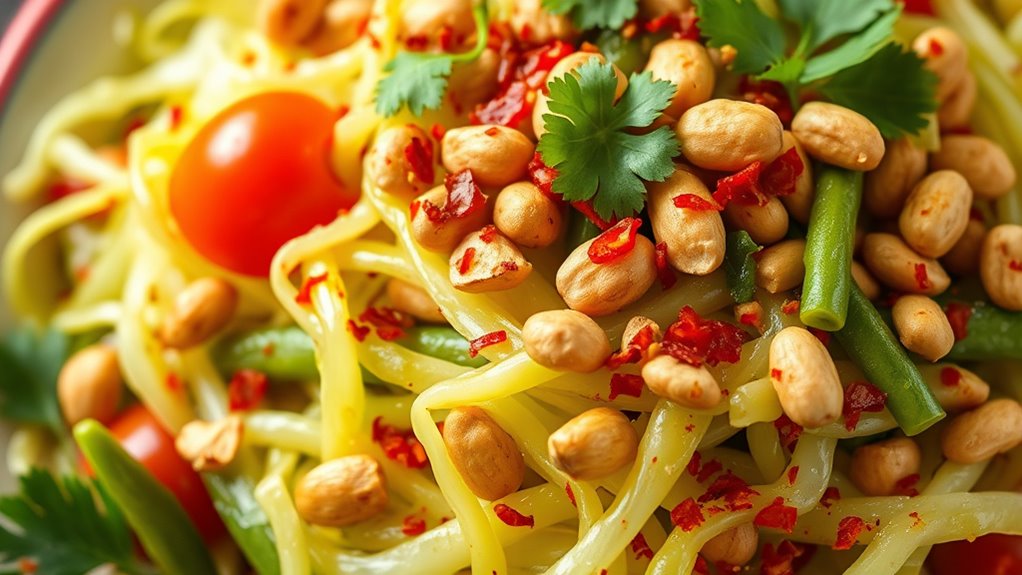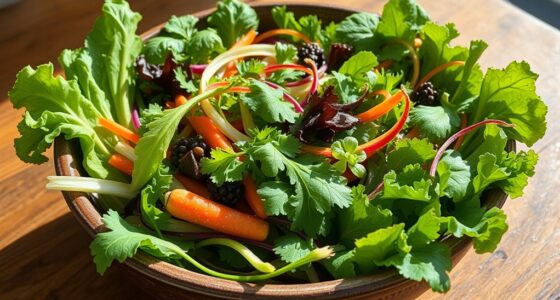Thai som tum is a lively, spicy green papaya salad that showcases Thailand’s rich culinary history. You’ll find it combines shredded green papaya with chili, lime, fish sauce, and peanuts for a perfect balance of tang, heat, and crunch. Variations include dried shrimp, tomatoes, or long beans, all maintaining its signature bold flavor. Exploring its flavors reveals centuries of regional influence and cultural significance—continue on to discover more about this iconic dish.
Key Takeaways
- Thai Som Tum is a spicy, tangy salad made primarily with shredded green papaya, lime, chili, and fish sauce.
- Peanuts add crunch and flavor, enhancing the dish’s texture and depth.
- Variations may include dried shrimp, fermented fish, tomatoes, or long beans for regional differences.
- Originating from northeastern Thailand, it reflects the country’s rich culinary history and local ingredients.
- Its popularity has grown internationally, showcasing Thailand’s diverse flavors and cultural influence.

Thai Som Tum is a vibrant and flavorful salad that captures the essence of Thai cuisine. When you taste it, you’re enjoying more than just fresh ingredients—you’re experiencing a dish with a rich culinary history that reflects Thailand’s diverse regional influences. Originally rooted in the northeastern part of Thailand, known as Isaan, Som Tum has evolved over centuries from simple, rustic food to a celebrated national dish. Its origins trace back to traditional farming communities where green papaya was abundant, and locals combined it with chili, lime, and fish sauce to create an invigorating, tangy, and spicy salad. Over time, this dish spread across Thailand, adapting to regional tastes and ingredients, which is why you find many variations today. In the northern and central regions, for instance, the salad might include more sugar or different types of chili, giving each version a unique flavor profile. The culinary history of Som Tum reveals how it has been shaped by local ingredients and cultural exchanges, making it a dish that’s both simple and complex in its origins.
As you explore different regional variations, you’ll notice how the core ingredients stay consistent—green papaya, chili, lime, and peanuts—but the preparation and added elements shift depending on where you are. In some areas, you might find dried shrimp or fermented fish, adding depth and umami to the salad. In others, fresh tomatoes or long beans are incorporated to enhance texture and flavor. This versatility is part of what makes Som Tum so beloved across Thailand; it adapts to local tastes while maintaining its signature spicy, tangy character. The dish’s popularity has even spread internationally, but no matter where you try it, understanding its regional roots adds depth to your appreciation. Every bite connects you to centuries of Thai food culture, highlighting how ingredients and flavors have traveled and transformed through regional variations. Additionally, the influence of cultural exchange has played a role in how this dish has evolved and gained popularity beyond Thailand’s borders. Whether you enjoy it in a bustling street market in Bangkok or a quiet village in Isaan, the dish embodies the culinary history and regional diversity of Thailand. The salad’s popularity has even spread internationally, but no matter where you try it, understanding its regional roots adds depth to your appreciation. Every bite connects you to centuries of Thai food culture, highlighting how ingredients and flavors have traveled and transformed through regional variations. So, when you prepare or savor Som Tum, remember you’re partaking in a dish with a storied past—one that celebrates Thailand’s culinary history and regional diversity with every spicy, tangy, crunchy bite.
Frequently Asked Questions
Can I Make Som Tum Vegan or Vegetarian?
Yes, you can make som tum vegan or vegetarian by using vegan substitutes for fish sauce and dried shrimp. For vegetarian options, replace these with soy sauce or mushroom sauce. You can also add extra vegetables like cherry tomatoes or carrots for more flavor and texture. Just guarantee all ingredients are plant-based, and you’ll enjoy a delicious, vegan or vegetarian som tum that retains its authentic spicy, tangy taste.
What Are Some Variations of Som Tum Across Thailand?
You might think all som tum is the same, but regional flavors and ingredient substitutions make each version unique across Thailand. In the north, you’ll find it milder with dried shrimp, while the south offers a tangier, coconut-infused variation. In central regions, sweet tamarind and crunchy beans shine. Don’t hesitate to swap ingredients; it’s the best way to explore diverse flavors and find your favorite style of som tum.
How Do I Adjust the Spice Level for Beginners?
To adjust the spice level for beginners, start by reducing the amount of chili peppers or removing the seeds, which hold most of the heat. You can also add more ingredients like shredded green papaya, lime juice, and fish sauce to balance the flavors and mellow the spice. Taste as you go, and remember that flavor balancing is key to making it enjoyable without overwhelming heat.
What Are Traditional Side Dishes Served With Som Tum?
You’ll find that traditional side dishes like sticky rice, grilled chicken, or crispy pork often accompany som tum, reflecting its cultural significance in Thai cuisine. These pairings balance the salad’s spicy, tangy flavors and showcase ingredient variations like salted egg or dried shrimp. You might also see fresh vegetables or rice crackers served alongside, enhancing the meal’s texture and cultural authenticity.
How Long Does Homemade Som Tum Last in the Fridge?
You should enjoy homemade som tum within 1 to 2 days for the best flavor and freshness. To maximize shelf life, store it in an airtight container in the fridge and keep it chilled. Remember, storage tips like keeping it cold and sealed help prevent spoilage. After 2 days, the salad may lose crunch and flavor, so it’s best to eat it sooner rather than later for ideal taste.
Conclusion
Now that you’ve mastered Thai Som Tum, you’re holding a vibrant burst of flavors in your hands. With its perfect balance of spicy, tangy, and crunchy elements, this salad is a culinary rainbow on a plate. Think of it as a symphony of taste, each bite hitting all the right notes. So, go ahead—dive into this spicy adventure and let your taste buds dance in celebration of Thai tradition.









